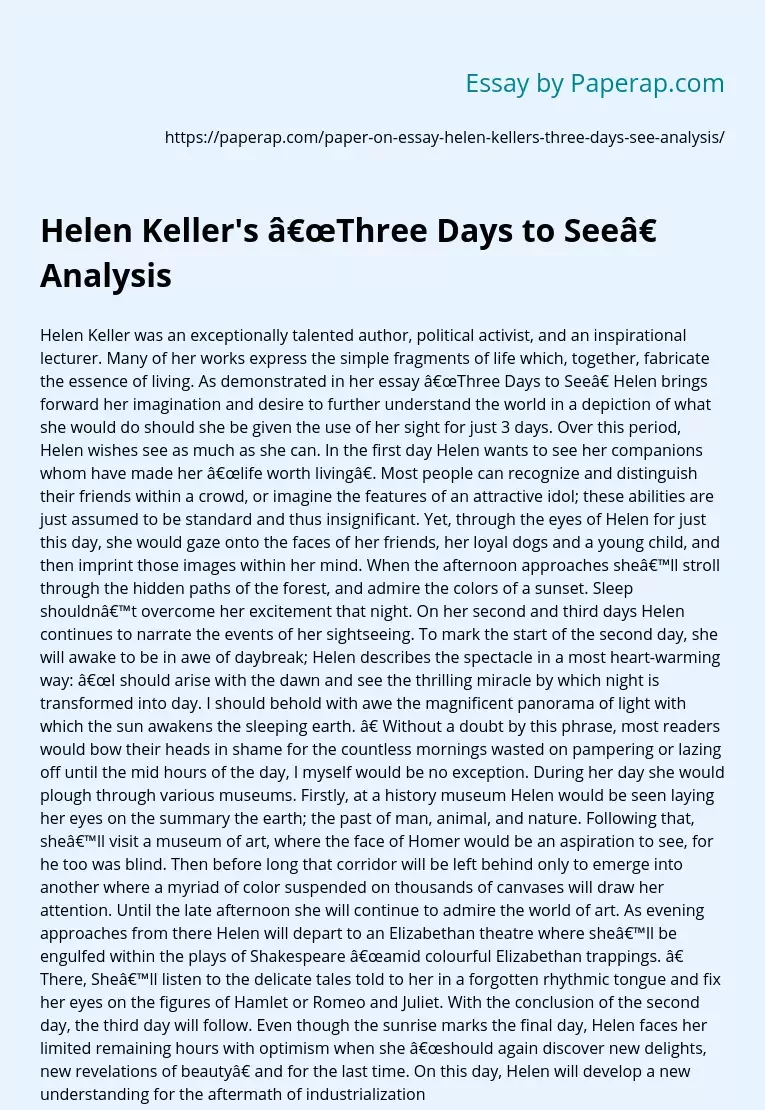Helen Keller's “Three Days to See” Analysis
Helen Keller was an exceptionally talented author, political activist, and an inspirational lecturer. Many of her works express the simple fragments of life which, together, fabricate the essence of living. As demonstrated in her essay “Three Days to See” Helen brings forward her imagination and desire to further understand the world in a depiction of what she would do should she be given the use of her sight for just 3 days. Over this period, Helen wishes see as much as she can.
In the first day Helen wants to see her companions whom have made her “life worth living”.
Most people can recognize and distinguish their friends within a crowd, or imagine the features of an attractive idol; these abilities are just assumed to be standard and thus insignificant. Yet, through the eyes of Helen for just this day, she would gaze onto the faces of her friends, her loyal dogs and a young child, and then imprint those images within her mind.
When the afternoon approaches she’ll stroll through the hidden paths of the forest, and admire the colors of a sunset. Sleep shouldn’t overcome her excitement that night. On her second and third days Helen continues to narrate the events of her sightseeing.
To mark the start of the second day, she will awake to be in awe of daybreak; Helen describes the spectacle in a most heart-warming way: “I should arise with the dawn and see the thrilling miracle by which night is transformed into day.
I should behold with awe the magnificent panorama of light with which the sun awakens the sleeping earth. ” Without a doubt by this phrase, most readers would bow their heads in shame for the countless mornings wasted on pampering or lazing off until the mid hours of the day, I myself would be no exception.
During her day she would plough through various museums. Firstly, at a history museum Helen would be seen laying her eyes on the summary the earth; the past of man, animal, and nature. Following that, she’ll visit a museum of art, where the face of Homer would be an aspiration to see, for he too was blind. Then before long that corridor will be left behind only to emerge into another where a myriad of color suspended on thousands of canvases will draw her attention. Until the late afternoon she will continue to admire the world of art.
As evening approaches from there Helen will depart to an Elizabethan theatre where she’ll be engulfed within the plays of Shakespeare “amid colourful Elizabethan trappings. ” There, She’ll listen to the delicate tales told to her in a forgotten rhythmic tongue and fix her eyes on the figures of Hamlet or Romeo and Juliet. With the conclusion of the second day, the third day will follow. Even though the sunrise marks the final day, Helen faces her limited remaining hours with optimism when she “should again discover new delights, new revelations of beauty” and for the last time.
On this day, Helen will develop a new understanding for the aftermath of industrialization. Her destination is the city where she’ll fade into the background while watching people pass, happily admiring the mesh of 10 000 individual entities; “I stroll down Fifth Avenue. I throw my eyes out of focus, so that I see no particular object but only a seething kaleidoscope of color. ” Perhaps, within the mass, Helen alone would notice the magnificence of a metropolis; simply savouring the flavour of the city, from its parks to its factories and even to its slums.
From there until midnight Helen will continue discovering as much of society as she can, making up for lost years before and all those thereafter. Through her three days readers must have learned something Helen’s character through the things she desires to see. They are all very ordinary and rarely acknowledged to be of significant beauty. The author brings to attention the little joys of life which are often taken for granted. On one occasion Helen tested her friends for their knowledge through their sight by asking a friend who had just returned from a walk, what she observed. Nothing in particular” was the lady’s reply. To this Helen was taken aback as there is a great deal that interests her though she cannot see nor hear; “I who cannot see finds hundreds of things to interest me through mere touch. ” Helen Keller’s “three days to see” highlights how subtly fortunate nearly everyone is; “if I can get so much pleasure from mere touch, how much more beauty must be revealed by sight. ” Both deaf and blind, Helen believes life should be lived to the fullest and to live everyday as if it were the last.
Helen Keller's “Three Days to See” Analysis. (2017, Mar 17). Retrieved from https://paperap.com/paper-on-essay-helen-kellers-three-days-see-analysis/

